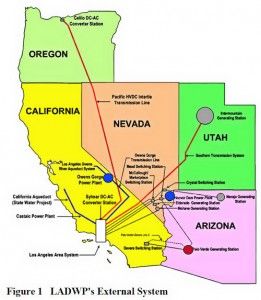Will ‘maquila-solar’ zone form just outside CA state line?
by CalWatchdog Staff | July 10, 2013 10:48 am
 [1]July 10, 2013
[1]July 10, 2013
By Wayne Lusvardi
Political borders create economic fault lines. For example, property rights might promote growth in one area, while lower wage rates might benefit another.
A good example is the “maquiladora[2]” free-trade zone flourishing just across America’s border with Mexico the past 50 years. It boasts lower wage rates than in the United States to the North. And the Mexican government has reduced regulations and encouraged growth.
Now a “maquila-solar zone” may be growing just the other side of California’s borders in neighboring Utah, Oregon, Arizona and Nevada. The “maqulia-solar” phrase was coined by energy expert [3]Chris Clarke [4]on his National Wind Watch news site.
Clarke noted a recent non-precedent opinion[5] by Judge Richard Posner of the U.S. 7th Circuit Court of Appeals that Michigan’s in-state renewable energy mandate is unconstitutional.
In the Michigan case[6], new transmission lines were planned to bring Western wind energy to the Great Lakes and Great Plains states. Midwestern electric ratepayers were expected to pay for the new transmission lines. But the state of Michigan sued on the basis that Michigan utilities are prohibited by state law from buying wind-generated electricity from out of state to meet its 10 percent green power mandate. If all green power had to come from inside the state, then Michigan electric ratepayers should not be asked to pay for transmission lines for green power they could not use.
The opinion means Michigan cannot erect a trade barrier against buying out-of-state green power. Posner’s opinion is called “dicta,” or commentary, and does not set a binding precedent on California. But Judge Posner is a respected constitutional expert and other federal judges often defer to his decisions and opinions.
As Posner aptly noted, “Michigan cannot, without violating the commerce clause of Article I of the Constitution, discriminate against out-of-state renewable energy.” The commerce clause gives the federal government the sole authority to regulate trade among the 50 states. The Founding Fathers placed that in the Constitution to prevent trade wars between states, such as California putting up a tariff against cars made in Michigan; or Michigan putting up a tariff against software designed in California.
The commerce clause thus established a continent-wide free trade zone that has been crucial to America’s prosperity.
L.A.’s stealth monopoly power grid system
Unlike Michigan, California’s green laws do not prohibit purchase of out-of-state energy. But several California policies favor developing and buying green power from within the state rather than from neighboring states, thus imposing a kind of soft protectionism. Such policies might come under attack after Posner’s decision.
First, California policy steers development of new solar projects within the state[7] by influencing new transmission line routes.
Second, the California electric grid operator uses a complex “Smart Grid” system called “dynamic transfer” to monitor and steer how much green power is being used. Smart metering[8] apparently is a system to assure only “Made in California” green power gets to market, according to Clarke.
Third, Gov. Jerry Brown fast-tracked approvals of new solar farms in California’s deserts[9] to compete with out-of-state power generated under fewer regulatory restrictions.
Fourth, the Los Angeles Department of Water and Power and the Southern California Power Authority buy out-of-state green power routed through its dedicated power lines. The Southern California Power Authority[10] supplies electricity to its member cities: Anaheim, Azusa, Banning, Burbank, Cerritos, Colton, Glendale, Los Angeles, Pasadena, Riverside, Vernon and the Imperial Irrigation District.
However, LADWP’s interstate transmission lines use direct current[11] instead of alternating current technology specifically so that the statewide grid cannot tap its power. LADWP routes its power through a Converter Substation in Sylmar, Calif.[12] to reconvert electrons back into alternating current to supply customers. The SCPA also operates a closed system grid that is not open to the competitive market because of its direct current technology.
Proposition 39 targets out-of-state energy suppliers
Additionally, California voters passed Proposition 39[13] in 2012 to close alleged “loopholes” in state tax law to equalize California’s ability to compete with outside green power. It raised taxes $1 billion a year.
Specifically, Prop. 39 requires out-of-state businesses of any type (not just energy companies) to calculate their income tax liability based on the percentage of sales in California. It repealed a previous law that allowed out-of-state companies to base tax payments on other factors beside in-state sales.
Prop. 39 mandates that about $550 million of the new taxes must fund energy efficiency projects in California. Prop. 39’s primary supporter was billionaire hedge fund manager Tom Steyer. His Farallon Investments also manages energy funds for the California Public Employees’ Retirement System.
There has been a backlash[14] against California’s restrictive policies by neighboring Western states.
With Posner’s new opinion, Clarke foresees a 961-mile long “maquila-solar” green-energy zone running along the Northern and Southeastern California. Electricity production would locate there to provide electrons to Californians, thus helping California meet green energy mandates, without suffering the hassles of California environmental laws.
For example, two years ago Brown signed into law a mandate[15] that 33 percent of all energy used in California must come from “renewable” sources by 2020. If energy companies start ramping up “green” energy production in the “maquila-solar” areas outside California, Posner’s opinion indicates that there’s little California could do to stop them from taking over a large part of the Golden State green electron market.
- [Image]: http://www.calwatchdog.com/2013/07/10/will-maquila-solar-zone-form-just-outside-ca-state-line/ladwp_transmission_grid_500/
- maquiladora: http://www.thefreedictionary.com/maquiladora
- coined by energy expert : https://www.wind-watch.org/news/2013/06/13/midwest-court-ruling-may-ease-energy-sales-into-california/
- Chris Clarke : https://www.wind-watch.org/news/2013/06/13/midwest-court-ruling-may-ease-energy-sales-into-california/
- non-precedent opinion: http://media.ca7.uscourts.gov/cgi-bin/rssExec.pl?Submit=Display&Path=Y2013/D06-07/C:11-3421:J:Posner:aut:T:fnOp:N:1148803:S:0
- Michigan case: http://www.michigancapitolconfidential.com/18830
- steers development of new solar projects within the state: http://www.wecc.biz/committees/BOD/TEPPC/20110809/Lists/Minutes/1/Letter%20to%20TEPPC%20from%20California.pdf
- Smart metering: http://www.kcet.org/news/rewire/the-grid/california-to-west-keep-your-renewables.html
- fast-tracked approvals of new solar farms in California’s deserts: http://www.calwatchdog.com/2011/11/26/calpers-manager-wants-tax-on-competitors/
- Southern California Power Authority: http://www.scppa.org/pages/misc/about.html
- direct current: http://www.publicpower.org/Media/magazine/ArticleDetail.cfm?ItemNumber=33708
- Converter Substation in Sylmar, Calif.: http://www.ladwpnews.com/external/content/document/1475/161235/1/Sylmar%20Converter%20Station%20Modernization%20Project%20.pdf
- Proposition 39: http://ballotpedia.org/wiki/index.php/California_Proposition_39,_Income_Tax_Increase_for_Multistate_Businesses_(2012)
- backlash: http://www.kcet.org/news/rewire/the-grid/california-to-west-keep-your-renewables.html
- signed into law a mandate: http://www.sfgate.com/business/article/Brown-signs-law-requiring-33-renewable-energy-2375758.php
Source URL: https://calwatchdog.com/2013/07/10/will-maquila-solar-zone-form-just-outside-ca-state-line/